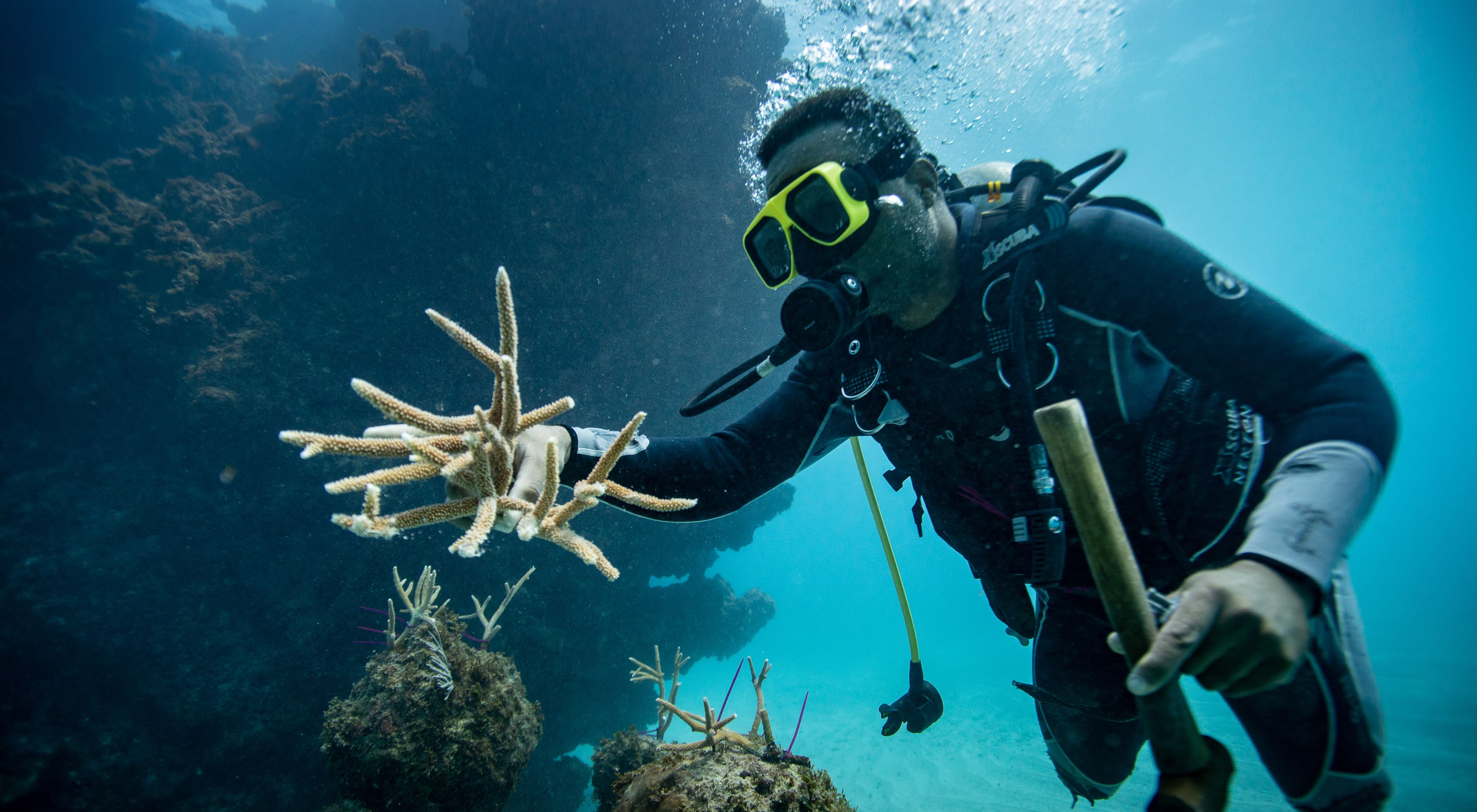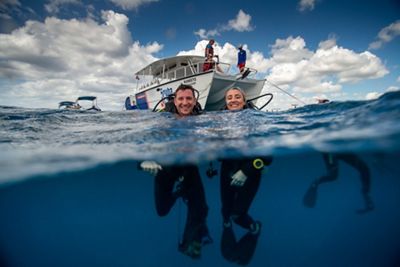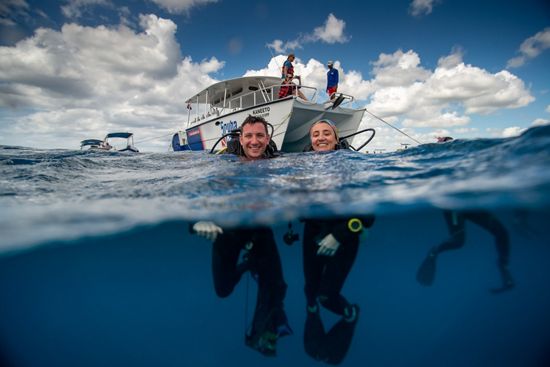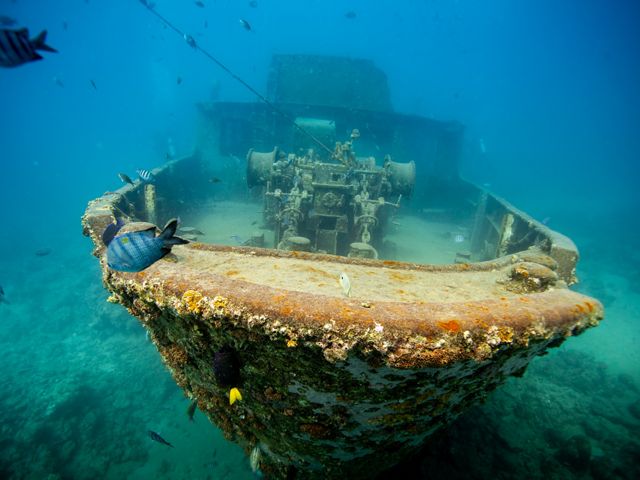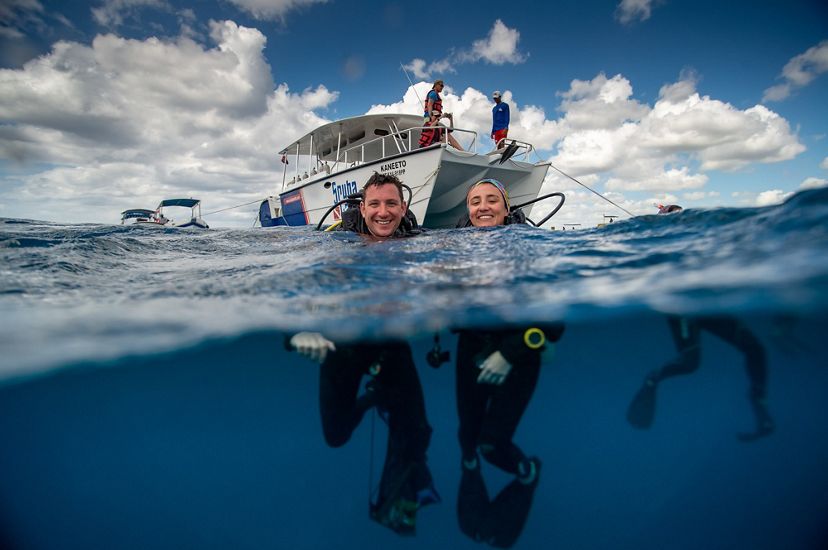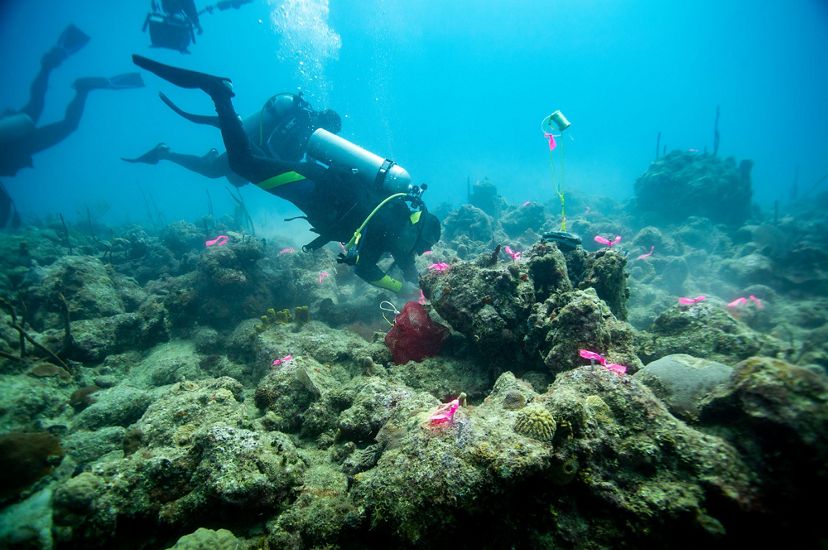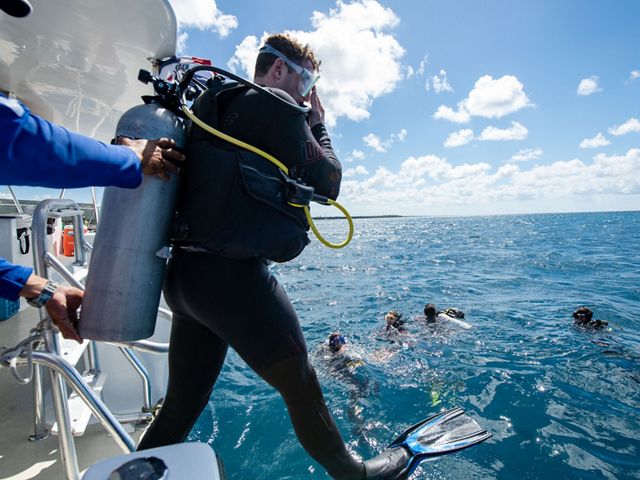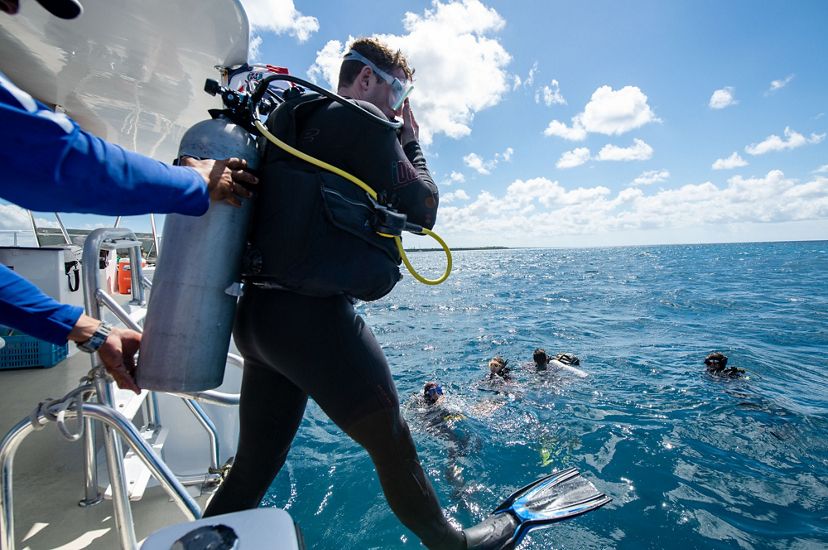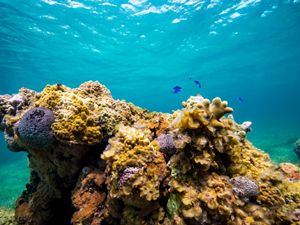Restoring the Reef
Journey to the Caribbean to hear about a coral reef restoration firsthand in the premier podcast episode of Destination Nature.
Destination Nature: Restoring the Reef
Click the green arrow below to hear episode one of Destination Nature.
Stacy Raine [SR]: This is Destination Nature, a podcast by The Nature Conservancy that takes you into the field to hear the boots-on-the-ground stories behind conservation projects from all around the globe. I’m Stacy Raine. Today we’re visiting the Caribbean to take a look at our work restoring coral reefs.
Joe Pollock [JP]: Getting gear set up so putting the BCD on that’s what helps us get control how high in the water we stay then putting on the regulators these are what let us breath under water essentially and yeah just strapping them on to the dive tanks so this has our compressed air to make sure that we can act like fishes and breath underwater.
SR: Marine Scientist Joe Pollock and a whole team of divers are just off the coast of Bayahibe in the sparkling turquoise waters of the Caribbean Sea. It’s a sunny tourist destination that was once a simple fishing village in the southeast of the Dominican Republic.
They finish suiting up in their dive gear and put regulators in their mouths. Then, they each take a long stride off the diving boat and hit the water. In three more boats spread out over a couple of kilometers, other teams of divers do the same.
JP: Alright, we’ll see you guys down below
SR: As Joe’s team descends, they pass an old shipwreck and they see thousands of fish, swimming in and around it. It’s stunning, but this dive isn’t about seeing a shipwreck or even the wildlife that love to haunt it. Today, they are heading more than 30 feet below to the ocean floor to restore a struggling coral reef. On this big blue planet of ours, coral reefs are one of the most important hidden keys to making our oceans healthier. But Joe is worried, because in the last 30 years, more than half the coral reefs in the Caribbean have died off.
JP: There’s been dramatic declines in coral cover in the Caribbean and, uh, particularly in some of these locations where these reef restoration efforts are focused.
It’s a balance and it’s a battle for space down there. What we’ve had in the last several decades in the Caribbean is what you would call a phase shift. Where we’ve gone from corals being the dominant organism and being able to maintain that dominance, to now we’re in a place in many locations in the Caribbean, where we’re in an algal dominated state. So, the algae have taken over, they’ve taken over huge swaths of the sea floor, and once they come in and once they’ve established themselves, it’s really hard for the corals to come back and regain that space. It’s a tough place down there for corals.
SR: Coral reef everywhere are in trouble but people like Joe Pollock are working hard to figure out how to help them. Most of the divers here today are volunteers that have come from all over the Dominican Republic, but for Joe, restoring coral reefs is a job. As a scientist at TNC, Joe spends a lot of time studying coral reefs and thinking about how TNC can protect the reefs in the Caribbean.
These four teams of divers are doing this work as part of Coral Mania an event by TNC partner Fundemar, an organization that focuses on marine conservation in the Dominican Republic. During the three days of Coral Mania, the divers will painstakingly plant more than a thousand coral fragments onto these reefs and they’ll do it using materials you’d find at your local hardware store: nails and zip ties. Over time, those fragments will grow, reproduce, and help bring the reefs back to health.
JP: When you’re down there, it’s, it’s a pretty amazing sight. You’re looking around and you’re just seeing dozens of other people and their dive buddies just working incredibly hard. You see them, their head down, their mask down, just hammering away. They’re trying to get as much work done as they possibly can, given that they’re basically on a timer, which is how much air they have in their tanks. So, they’re just furiously working.
SR: Joe is telling me about the reef restoration process, a process that TNC has helped pioneer—how they spend days doing this work and what it’s like to be down there. It’s tough work, it’s beautiful work, and on Day 1, it’s actually loud work too. The first day of restoration, they’re cleaning off algae and driving nails into the reef, and if you’re curious what it sounds like:
JP: the hammering sounds like hammering
When you’re down there and you know what the sound of the hammering is though, it sounds like it’s the sound of corals getting ready to be planted. So, it’s not like when your neighbors having their house worked on, you’re like, oh, wish someone would stop that racket. You’re like, let’s get more of that racket. That’s exactly what we came here to do.
Rita Sellares [RS]: You can hear a lot of clack, clack, clack, clack the first day because everybody’s with the hammer.
SR: And that’s Rita Sellares. She’s the executive Director of Fundemar. TNC has a long relationship with Rita and Fundemar, beginning years ago with an effort to survey the reefs and understand whether they were healthy enough to provide habitat for the sea life that depended on them.
Healthy coral reefs are some of the most beautiful and interesting habitats on earth—vibrant and colorful sights to behold, packed with all sorts of marine life—fish, of course, but also snails, octopi, turtles, lobsters, sharks, and so much more. Corals look like a strange combination of plant, flower, and rock and it seems like they can’t possibly be a living thing, connected on a grand scale. Yet, the reef is very much alive. Corals are actually giant colonies of animals.
JP: The amazing part is that these immense structures are formed by millions, hundreds of millions, maybe billions of tiny coral polyps, some of which are almost microscopic.
They’re invertebrates, which means they don’t have a backbone, and they’re also really closely related to jellyfish. In fact, one way to think about a coral is almost like an upside-down jellyfish in a skeleton cup. So, they have these tentacles that they can use to capture food but in fact that’s not their main source of food. Corals get most of their energy from the algae that lives as a part of the coral animal.
SR: Joe is talking about a different type of algae than the algae that’s competing with corals for space on the sea floor. He is referring here to the single-celled algae that corals pull in from the water to live inside them, creating a symbiotic relationship, and giving corals their color.
JP: Those algae basically work like little solar cells, collecting the sun’s energy, turning them into sugar, and then in turn, sharing that sugar with the coral animal. And in return, the coral animal gives those small microscopic algae a safe place to live where they don’t have to worry about getting eaten or washed away in, in the current.
SR: These tiny coral animals build skyscrapers of skeleton over thousands of years, inching their way higher and higher, and then they sit atop that mountain of skeleton they’ve left below. The colony of coral animals together makes up the amazing shapes you find on coral reefs. Some look like branches, some look like antlers, some even look like a human brain. It’s these shapes that provide food and shelter for an amazing diversity of marine life.
And although they only make up just point one percent of the world’s surface—so just one tenth of one percent—their impact is enormous.
JP: A really staggering twenty-five percent of all marine fishes spend at least one point of their life cycle on coral reefs. So, they really are those nurseries that are helping to bolster populations of fishes that you never even would think of as necessarily being tropical coral reef fishes.
SR: With so much going on and so many species relying on the reefs, you can imagine how critical they are to the health of our oceans. But you know what? Our species relies on reefs too. It’s calculated that around a hundred million people depend on the reefs directly for their livelihoods or even for their food, especially people who live in remote island communities. Coral reefs, though, provide us with so much more than food. For one, they are extremely effective at breaking waves, which not only protects places, like homes and businesses, but more importantly protects people.
JP: Coral reefs can break up wave energy. In fact, they’re known to reduce wave energy by ninety seven percent, which is really important for coastal communities.
They also provide a lot of benefits in terms of world economies. So, a lot of economies in the tropical regions, particularly in the Caribbean, have coral reef ecosystems as one of the major draws for tourists to come. They want to see that clean blue water. They want to dig their toes into that white sand.
In fact, that white sand is produced by little pieces of coral that have been bitten off by parrot fish and pooped out. So that’s kind of an interesting thing to think about the next time you’re on a reef or on a beach. But, um, those beautiful white sands, they’re produced by coral reefs.
SR: In addition to making these beautiful beaches, parrot fish also act like little lawnmowers and keep the problematic algae in check.
Joe also pointed out that biodiversity on coral reefs provides a source for medicine. New medicines treating illnesses like Alzheimer’s, viruses, and bacterial infections are coming out of the reef ecosystem. But this isn’t new. For decades, life-saving medicines derived from coral reefs have been used to treat certain types of cancer.
These reefs—they’re important. But here’s the thing: there are a lot of threats to coral reefs. Joe calls it “death by a thousand cuts.”
The biggest threat … is climate change:
JP: So, climate change means that we’re having warmer oceans, corals really are a symbiosis between the coral animal and the algae. And that’s a delicate symbiosis. They need to live in a very narrow range of temperatures. And if that temperature gets too hot that mutually beneficial relationship breaks down.
That means that the algae are expelled, that’s why we see these white corals that we call bleached.
SR: When the algae leave the coral animal, the coral no longer has its main source of food. If the temperature of the water doesn’t come down, giving the coral and algae a chance to reestablish their symbiotic relationship, the coral will die.
Joe tells me that there is also a lot happening locally—right at or near the reefs, that greatly impact their health. Things like overfishing:
JP: So particularly taking out herbivorous fish or fish that eat algae like parrot fish, uh, that can be very deleterious to the reef because you’re upsetting that balance, that competition for space between the coral and the large fleshy algae, they cannot take over out compete the coral.
SR: And also, coastal runoff—dirt and other contaminants washing from places like cities and farms and into the water, making the water not only dirty but also cloudy, blocking the light that corals need to survive. And shockingly, sewage is a problem—in many cases it is dumped, raw and untreated, right into the ocean.
Even beachgoers can cause harm, because many sunscreens are dangerous for corals. And, if snorkelers and divers aren’t careful where they put their fins, they can damage the reef.
JP: So, you’ve got all these different things happening at the same time and the more of them, more of the stressors that we can remove, the better probability we have of coral reefs being able to thrive.
SR: With so many threats to corals, how do we help them?
JP: You need to know where the reefs are. You need to know how they’re doing, and you need to know how their status is changing over time. That helps you be sure that you can protect the most important coral reefs, that you can restore the most important coral reefs. And that you can really show that those interventions that you’re doing, whether the restoration protection or both are really having a net positive impact.
We also work to empower local partners to do effective marine protection or what we call marine spatial planning. So, in the Dominican Republic, for example, a TNC with a huge array of partners have helped it to get established an eight thousand square kilometer southeast Marine Park. So that’s huge. That helps to remove the drivers of degradation so, you can control things like overfishing. Ideally you can control things like, uh, nutrients coming into the sea. So, you’re able to remove those local stressors to then help the reefs, uh, sort of repair themselves and you can give them an additional bit of help by doing that active restoration.
SR: And the biggest key to success is building resilient coral colonies.
JP: Diversity is the key to adaptation and the key to resilience in biological systems. So, what we aim to do is maximize genetic diversity. So, when we’re doing coral restoration, we make sure that we’re not just working with one coral species. We work with a diversity of coral species that are all going to have different tolerances, different niches, different life history strategies, different abilities to adapt and tolerate different environmental conditions.
SR: So how do you build these diverse and resilient coral colonies? One way is with little coral nurseries. Fundemar began creating these nurseries, propagating new corals that could eventually serve as transplants.
Coral nurseries have become a common practice these days and they too are really beautiful in their own way. Imagine an area just off the coast, where the water is so clear that if you were to stick your mask in and look down, you could see straight to the bottom. Now imagine concrete blocks anchoring wide ladders of rope to the ocean floor. The rope ladders are held up by giant buoys, and on each wide rung little corals are wedged in, held in place by the rope’s tension. These tiny coral fragments are enjoying the sunlight streaming through the water and they are growing really fast.
They grow so fast, in fact, that Rita had a new problem. She had a lot of corals that needed to be transplanted to reefs, and not enough people to do the work.
RS: Um, so there was a moment that it was too big for us to be able to transplant at the same time that we were, uh, like the corals were growing too fast and our team, it was too small to be able to transplant all the tissue. So that’s when Coral Mania started.
SR: And they’ve been doing Coral Mania every year since it began four years ago. Rita decided that if she could train local people who had an interest in the reef—people from local dive shops, from the university, local fishermen, even people from the ministry of the environment—she could help them better understand corals. And she saw this idea working.
RS: They started to realize that the corals where animals, because they started to see the polyps, the tentacles.
Then suddenly it’s not a like just a reef that they didn’t know what it was. So only they start to see animals and colors and, and, and a special unique thing in each coral that they were seeing.
So, there was a lot of awareness and you could see the change. So, it’s it’s different. A fisherman that works with us telling all the fisherman the importance of coral reef and, and the other fisherman seeing this passion in these, these fishermen.
SR: Each year, Rita has helped more and more people get trained and Coral Mania has been exponentially more successful. TNC got involved, too, bolstering efforts by helping organize the event, providing logistical support and promoting Coral Mania.
RS: We started the first year just transplanting to two hundred fragments with the same people because it, it was difficult for them. Now this year we were able to transplant more than a thousand.
SR: By bringing in more people, not only can more work be done, but the impact could reach further than the shores off Bayahibe.
JP: By bringing these 50 people from all around the country, from all these different sectors together, uh, letting them learn these techniques, letting them participate and see and be part of how this can be done, they can bring that back to their communities. So, the positive work that we’re doing doesn’t just end with Coral Mania. It doesn’t just end with corals that, that, that have been planted. But this event can serve as a real catalyst to spark change and to spark new restoration efforts all throughout the country.
Our big driver is doing this in a scalable way. So, we’re developing these methodologies and developing this techniques that work not just in the Dominican Republic, not just in the Caribbean, but in coral reef systems right around the world. Uh, that’s the scale of the problem. And that’s the scale oat which we need to be thinking and acting.
SR: There are a lot of reef systems out there, and a lot of them are in danger. The Nature Conservancy believes this model can serve reefs.
JP: We want to create use cases, best practice manuals and others so that these kinds of successful programs can be replicated in other places around the Caribbean and globally.
SR: Back on the ocean floor, the divers are working in synchrony. They don’t look around much because time is limited and there’s a lot to do.
RS: Because once you are focused, you’re going to have a manatee or a dolphin just over your head and you’re just so focused hammering or just putting your coral that you don’t see a thing.
SR: They don’t see this wildlife seeing them, but there is actually plenty to hear around them.
JP: Reefs are very loud environments. You’ve got opposing shrimps, you’ve got all the people down there. The sound carries pretty well through the water. You’re hearing them nailing away, you’re hearing all of their bubbles float up to the top.
SR: The divers clean out the algae and drive nails into the dead coral on the first dive. On the second dive, they zip tie the coral fragments, no bigger than your thumb, onto the reef. The final day, they survey the work and make sure everything is just right. They clean up Then they ascend.
JP: And then when you’re going back up at the end of the dive, when everybody’s done, you look around and it’s just such a change.
RS: It’s really, it’s a really nice feeling. Yeah, it’s a really nice feeling seeing all these people just involve in coral conservation and trying to do their best and, and then once, once you see the results and you see all the, all the fragments that we have into the water. So it’s, it’s really, really nice.
JP: It’s a dramatic, dramatic change to see a patch of reef that’s gone from fairly barren to now. You just see these little bushes popped up everywhere. Um, these little, the bushes being the corals right. And it’s, it’s pretty heartwarming to see, uh, just that visual of a demonstration of what likeminded people working together towards the same goal can accomplish in, you know, really the course of a dive. It’s it’s it’s really it’s fun to be a part of a, it’s exciting to see.
SR: Three days, a thousand corals, a lot of hard work by a lot of dedicated people to bring these reefs back to health, so they can continue to protect and sustain life both underwater and on land. And they’ve created more ideas that can be shared around the world to help protect reefs everywhere for nature and people.
Thanks to Dr. Joe Pollock and Rita Sellares for being on this show.
Destination Nature was produced by Katie Bacon, Amy Hepler Welch, and me, Stacy Raine, with help from Beth Fiencke, Ben Knisely, and Kristin Mullen. Special thanks to Bradley Morgan Dale for the music, Dr. Ashlee Lillis for some of the sounds, and the Dallas Audio Post for their editing work on this show.
But most importantly, we are so grateful to our supporters who made this work, and this story about the work, possible.
Next time on Destination Nature: Journey with us to the Santa Ana mountains to explore why a population of mountain lions is facing extinction, and what we are doing to save them before it’s too late. Stay Tuned.
Fifty divers, four boats, three days and hundreds of tiny corals.
Dive below the sparkling turquoise waters of the Caribbean Sea with Nature Conservancy scientist Joe Pollock to go behind the scenes of a coral restoration on the very first episode of Destination Nature. Then hear from Rita Sellares of partner organization Fundemar on what it takes to pull off Coral Mania, an intensive three-day coral transplantation project.
Learn more about:
- How coral reefs are formed
- The threats to coral reefs
- What TNC is doing to protect and restore these places.
Coral Mania: A Visual Story
On the way to the coral reef divers encounter all sorts of marine life: fish, snails, octopi, turtles, sharks and more. They even pass by a shipwreck.
The divers have come from all across the Domincan Republic to learn from and participate in this restoration event.
Quote: Joe Pollock
It's a pretty amazing sight. You're looking around and you're just seeing dozens of other people and their dive buddies just working incredibly hard.
For Joe Pollock, the hope is that Coral Mania can serve as a catalyst to spark change and restoration efforts throughout the country.
Photo Gallery: Restoring the Reef




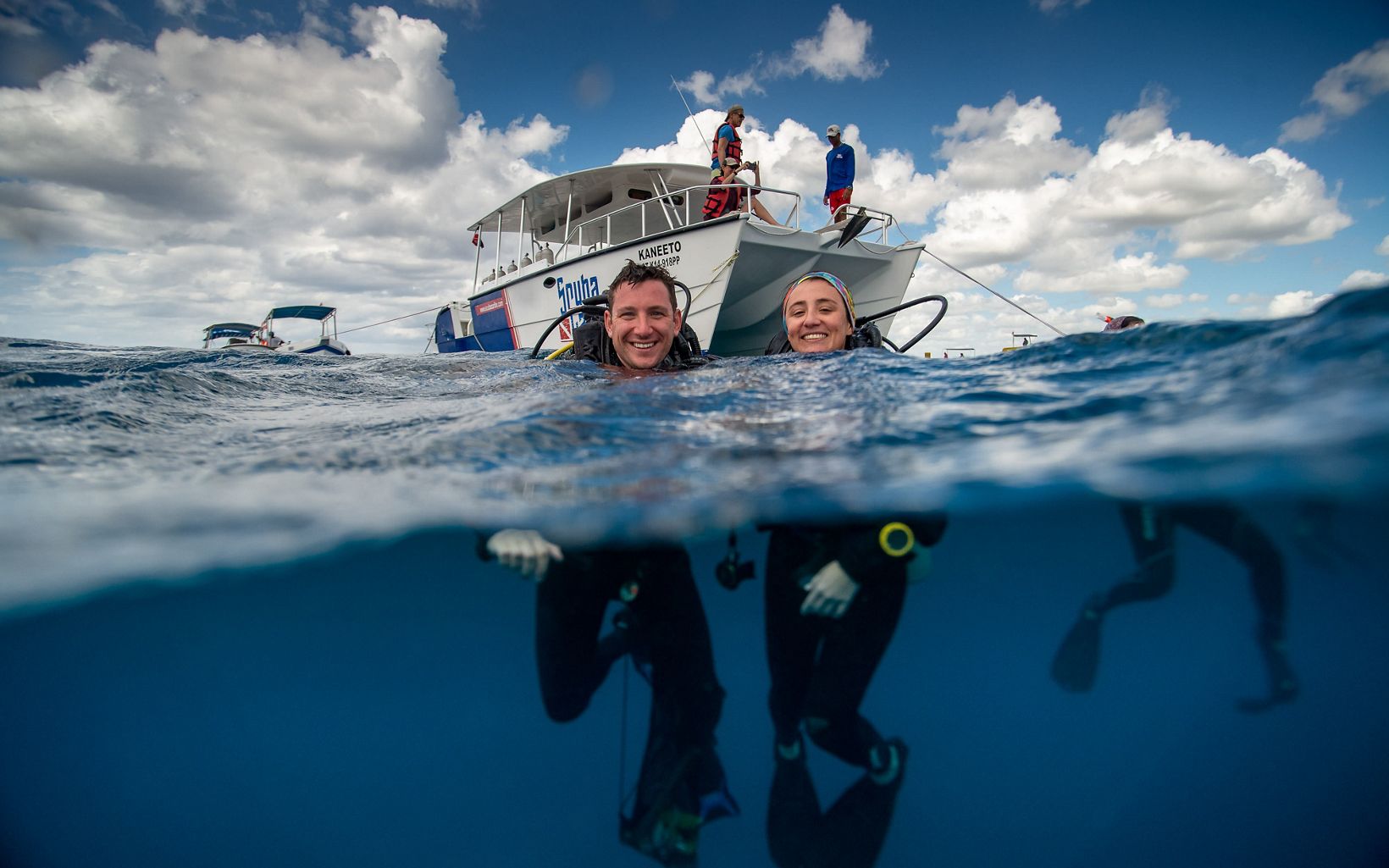
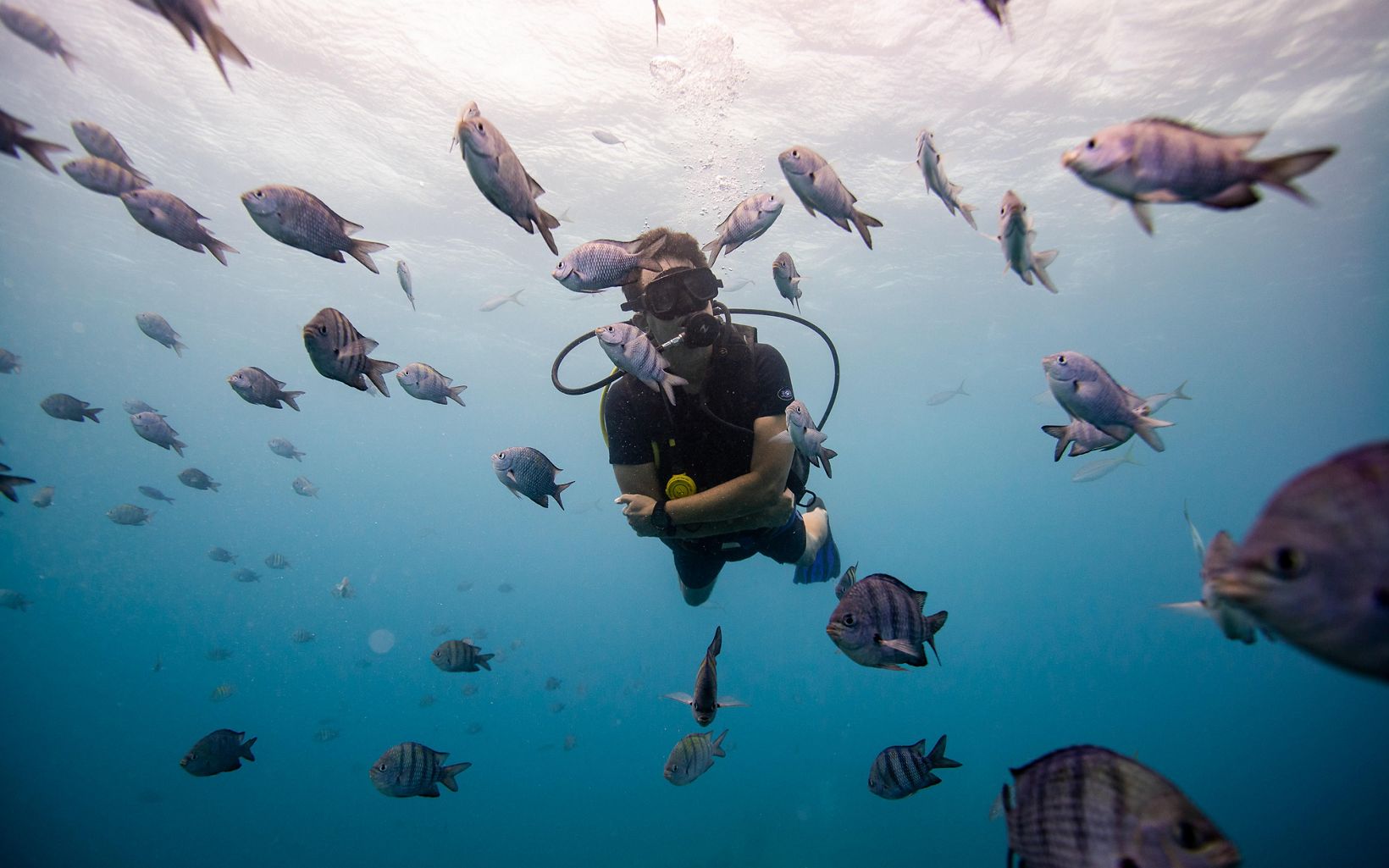


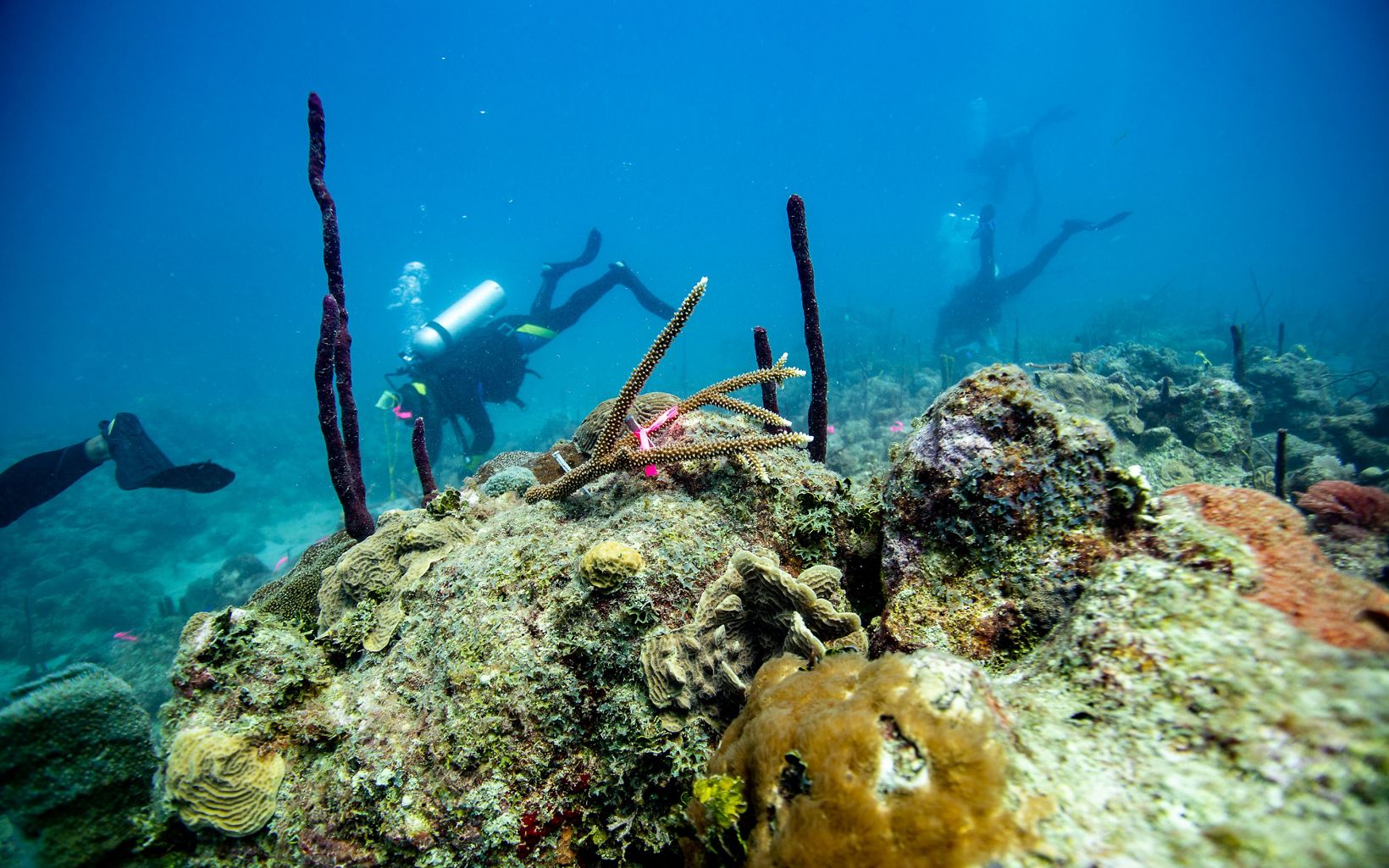















About Destination Nature
Destination Nature is a new podcast series from The Nature Conservancy that brings boots-on-the-ground conservation stories to your computer. Three pilot episodes will launch in the summer of 2019. In each episode we explore a new project, talking with TNC staff and partners about our work in action.
Email our team to share your thoughts about the Destination Nature podcast or to suggest topics for future episodes at destination.nature@tnc.org.
